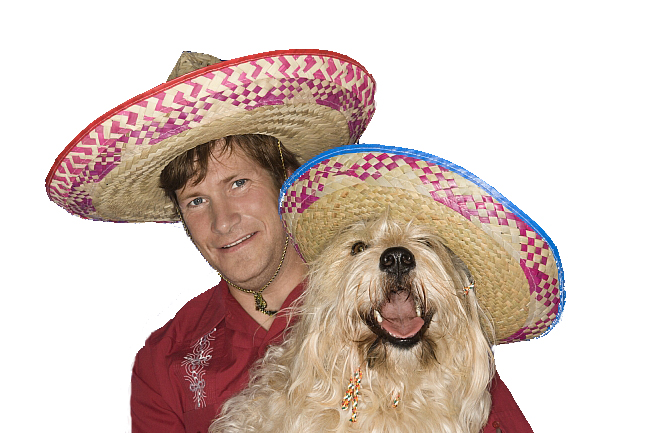 Admit it. You mumble useless gibberish to your dog whenever he does something right, or as you greet him at the end of a day. Things like, “Who’s a widdle biddle baby dog?” “Good boy, das a good good boy Rufus Dufus.” Whether it is the words we say (or the voice we say them in), or the wrestling games we play with our pups on the floor; most pet-owners aren’t afraid to be silly with their pet. However, the concept of putting on a brightly colored costume, and holding a tambourine while we conduct rigorous obedience training, isn’t the kind of thing most people want to sign up for. This method of instruction is called Proof Training, and though it may feel strange at first, has many practical uses out in the real world.
Admit it. You mumble useless gibberish to your dog whenever he does something right, or as you greet him at the end of a day. Things like, “Who’s a widdle biddle baby dog?” “Good boy, das a good good boy Rufus Dufus.” Whether it is the words we say (or the voice we say them in), or the wrestling games we play with our pups on the floor; most pet-owners aren’t afraid to be silly with their pet. However, the concept of putting on a brightly colored costume, and holding a tambourine while we conduct rigorous obedience training, isn’t the kind of thing most people want to sign up for. This method of instruction is called Proof Training, and though it may feel strange at first, has many practical uses out in the real world.
Proof Training is a canine stress test. It is a way you can rate your dog’s ability to retain commands and remember the skills he has learned, no matter what kind of distractions are around him. This is accomplished by performing the commands and signals in an environment racked with distractions, costumes, noises, and sights that are new to your dog.
It is imperative that you only begin Proof Training when your pup is well-versed in regular obedience training, getting 80-90% of commands correct on the first try. If he is not completely familiar with the commands, and able to recognize and obey them, then Proof Training will slow the process down rather than strengthen your dog’s skills.
Once practice begins, be sure to do something a little different each time, or your dog might simply associate training and obedience with the blue wig and pom-poms you wear. Keep your pup on his toes so that he will eventually learn to tune out the distracting shapes, sounds, colors, and smells.
Some Helpful Proof Training Tools:
- Wigs
- Large flamboyant hats
- Character or Plush costumes
- Light-up shoes, shirts, hats, headbands.
- Musical instruments such as : tambourines, drums, whistles, horns, noisemakers, etc.
- Streamers/Ribbons/Pom-poms
- Music to play in the background (can be loud music, or just unusual music and
- Hand clapping/Large movements
- Voice disguise/Accent change
Step 1: Start training indoors with the distractive tools. Begin slowly, incorporating a few things at once, and increasing the level of distraction. Wear the hat, the light-up shoes and blow the whistle. Go through all of the same commands you were accustomed to doing with him in regular training. Now turn the classic rock on, put on a costume, and run the training again. Do so multiple times weekly until your dog doesn’t notice the diversions any more.
Step 2: Train with him in an unfamiliar indoor environment. Bring him to a friend’s house who may have a pet bird or cat that would otherwise be a challenge to stay away from. Or do the training with him at a place where there are lots of children, new toys, sounds and smells which would excite or divert your puppy’s attention. Practice Proof Training with your dog where he is uncomfortably surrounded by distractions, so that he will learn to focus on and listen to you.
Step 3: Finally, practice training with him in the real world. Take him to a park with plenty of squirrels, or a busy road side that is partially under construction. Go for a walk in a neighborhood during Christmas season when all the lights and moving signs are ablaze. Whenever your dog disobeys, correct him and then give the command again.
Note: Having practiced the voice distortion/disguise tactic is a great way to accustom your dog to having to respond to you no matter what you sound like. There may be a time when you are far from your dog in a public place and need to call him back, or when the city and traffic noise around you may distort the familiarity of your voice. Because of your Proof Training, your dog should be well prepared to obey your call.
Step 4: REWARD your dog. This will be tough work at first, and your pooch will need plenty of encouragement and yummy treats along the way to make him feel he is doing well. Each time he obeys a command, give him a tasty bite. At the end of a particularly grueling training session, consider presenting him with a special bone to help him associate practice positively.
If the Proof Training is consistent, your canine pal will be able to navigate any number of confusing signs or diversions or interruptions while out in public with you. He will only consider these distractions to be tricks to keep him from focusing, and will be more likely to carry out the task at hand without a glitch. So don’t be afraid to put on a fuzzy clown wig and red nose –the payoff of unswerving devotion and obedience is worth it in the end.

